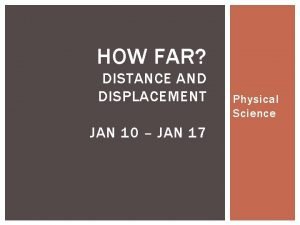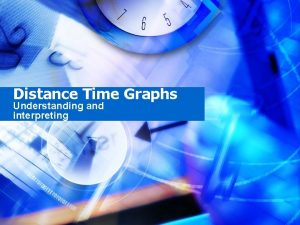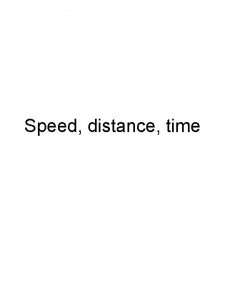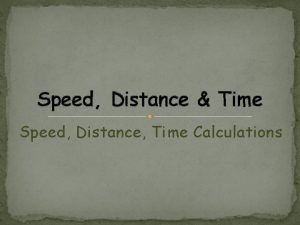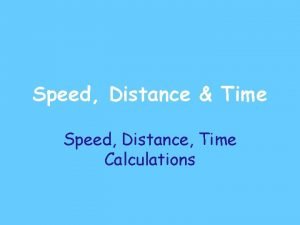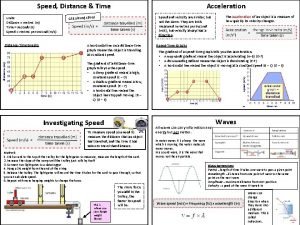12 1 Distance and Time Distance is the











- Slides: 11

12. 1 Distance and Time • Distance is the space between two points, commonly measured in metres (m). • Distances between two points can depend on the path taken. • Time (t) is the duration of an event. • Time is often referred to as a time interval and given the symbol t. • A period (T ) is the time interval between two repeating events, such as a pendulum swinging. • It is related to frequency as: • Graphs are used to illustrate the mathematical relationships of two quantities. VOCABULARY time interval slope

12. 2 Speed • By relating time and distance, we can determine speed, which is the distance an object travels ( d) divided by the time interval ( t). VOCABULARY speed average speed instantaneous speed • The average speed of an object is the total distance the object travelled divided by the total time taken. • Instantaneous speed is the speed of an object at a particular instant in time. • For example, a car speedometer reads instantaneous speed. • For an object travelling at a constant speed (i. e. uniform motion), the average speed is equal to its instantaneous speed.

12. 3 Graphing Distance and Time • A distance–time graph has distance on the y-axis and time on the x-axis. • The slope of a line on a distance– time graph is equal to average speed. • The units for the slope would be metres/second (m/s), the same as speed.

12. 3 Graphing Distance and Time • We can calculate the instantaneous speed of an object at a particular time by calculating the slope of the tangent to the line of the distance–time graph of the object’s motion. • Just as we can use distance and time data to construct a graph, we can derive information about distance, time, and speed from a graph.

12. 4 Displacement and Velocity • Distance and displacement are similar, but not identical concepts in science. • Distance is a scalar quantity (magnitude only). • Displacement is a vector quantity (magnitude and direction) • The displacement of an object is its change in position in relation to a point of reference. VOCABULARY scalar quantity displacement vector quantity velocity uniform motion

12. 4 Displacement and Velocity • Speed and velocity are also similar, but not identical concepts. VOCABULARY scalar quantity displacement • Speed is a scalar quantity (magnitude only). vector quantity • Velocity is a vector quantity (magnitude and direction). velocity uniform motion • Velocity is the rate of change of displacement and is given by the equation: • The slope of the line of a position– time graph is equal to the velocity of the object.

CHAPTER 12 Displacement, Time, and Velocity • The motion of an object can be described by displacement, time, and velocity. • Distance and displacement are similar but not identical concepts in science. • Speed and velocity are also similar but not identical concepts.

CHAPTER 12 Displacement, Time, and Velocity • Distance–time graphs and position– time graphs can visually display information about an object’s motion. • The slope of the line is equal to the speed or velocity of the object. • If the slope of the line is changing, the speed or velocity is not constant. • If the slope the line is constant, the object is travelling at constant speed or velocity.

CHAPTER 12 Displacement, Time, and Velocity • Quantities can be either scalar or vector. • Scalar quantities only have magnitude, which is a number with a unit. • Vector quantities have both a magnitude and a direction. • An object’s speed and velocity can be described in different ways. • For example, average speed or velocity, instantaneous speed, and uniform motion (constant speed or velocity).

CHAPTER 12 Displacement, Time, and Velocity Activity • With a partner, use a mind map to brainstorm different methods of measuring distance (including length and height of objects). • For example, you could measure using a ruler, using the length of your arm, etc. • Could all of your distance measuring methods be converted to have the same measurement units, such as metres? • If you wanted to measure the distance from school to your home, which method would you use? Explain. • For more information on distance, read page 341 in the textbook.

CHAPTER 12 Displacement, Time, and Velocity Key Ideas • The motion of an object can be described by displacement, time, and velocity. • Distance–time graphs and displacement–time graphs can visually display information about an object’s motion. • Quantities can be either scalar or vector. • An object’s speed and velocity can be described in different ways.


